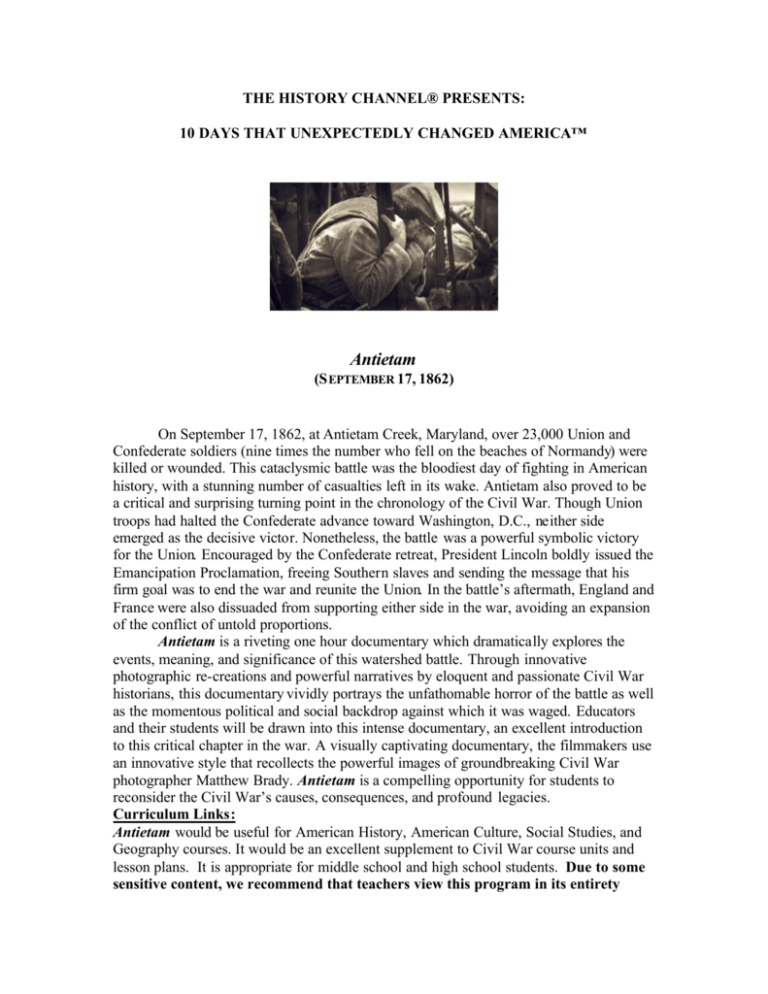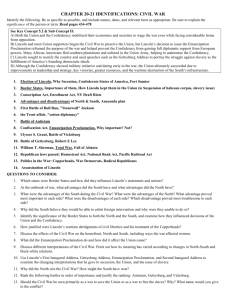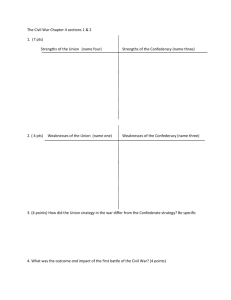Antietam - History Channel
advertisement

THE HISTORY CHANNEL® PRESENTS: 10 DAYS THAT UNEXPECTEDLY CHANGED AMERICA™ Antietam (S EPTEMBER 17, 1862) On September 17, 1862, at Antietam Creek, Maryland, over 23,000 Union and Confederate soldiers (nine times the number who fell on the beaches of Normandy) were killed or wounded. This cataclysmic battle was the bloodiest day of fighting in American history, with a stunning number of casualties left in its wake. Antietam also proved to be a critical and surprising turning point in the chronology of the Civil War. Though Union troops had halted the Confederate advance toward Washington, D.C., neither side emerged as the decisive victor. Nonetheless, the battle was a powerful symbolic victory for the Union. Encouraged by the Confederate retreat, President Lincoln boldly issued the Emancipation Proclamation, freeing Southern slaves and sending the message that his firm goal was to end the war and reunite the Union. In the battle’s aftermath, England and France were also dissuaded from supporting either side in the war, avoiding an expansion of the conflict of untold proportions. Antietam is a riveting one hour documentary which dramatically explores the events, meaning, and significance of this watershed battle. Through innovative photographic re-creations and powerful narratives by eloquent and passionate Civil War historians, this documentary vividly portrays the unfathomable horror of the battle as well as the momentous political and social backdrop against which it was waged. Educators and their students will be drawn into this intense documentary, an excellent introduction to this critical chapter in the war. A visually captivating documentary, the filmmakers use an innovative style that recollects the powerful images of groundbreaking Civil War photographer Matthew Brady. Antietam is a compelling opportunity for students to reconsider the Civil War’s causes, consequences, and profound legacies. Curriculum Links: Antietam would be useful for American History, American Culture, Social Studies, and Geography courses. It would be an excellent supplement to Civil War course units and lesson plans. It is appropriate for middle school and high school students. Due to some sensitive content, we recommend that teachers view this program in its entirety before showing it to students. It fulfills the following standards as outlined by the National Council for History Education: (1) Values, beliefs, political ideas, and institutions, (2) Conflict and cooperation, and (3) Patterns of social and political interaction. Key Terms : Students should identify the following terms. Visit www.mirriamwebster for definitions. Evolution Casualties Debacle Decisive Enforcements Garrison Habeas corpus Inevitable Remnant Succumb Comprehension Questions: 1. Do you think the Union and Confederate generals knew how important the bat tle at Antietam would be in the course of the Civil War? Why or why not? 2. According to this documentary, what were Abraham Lincoln’s thoughts on the Civil War? What does his famous quote “a house divided cannot stand” mean? 3. What did Lincoln consider in his decision to draft the Emancipation Proclamation and who was involved in the decision? 4. The Emancipation Proclamation declared that unless Confederates put down their arms and come back to the Union, then starting January 1, 1863, all slaves in the south would be freed. Lincoln used his power as Commander-in-Chief to confiscate property of southerners – the slaves. Was this an acceptable use of power in your opinion? Why or why not? 5. In the summer of 1862, Lincoln’s cabinet did not want him to sign the Emancipation Proclamation while the Union was losing because it looked like a desperate move. They told him to wait until they had a victory. Do you agree with the cabinet’s opinion? Why or why not? 6. Although Antietam was not a clear victory for the Union, Lincoln’s advisors told him it was sufficient enough to issue the Emancipation Proclamation. If Antietam had not occurred, do you think the Emancipation Proclamation would have been signed? Why or why not? 7. How did the Emancipation Proclamation affect society in the short-term and the long-term? 8. In 1862, some European leaders considered supporting the Confederates. How did the battle at Antietam change this? 9. What effect do you feel Antietam had on the public’s morale and attitude about the war? 10. What images or ideas in this documentary did you find most compelling? Most surprising? 11. If you had to describe the importance of the battle at Antietam to someone five years younger than you, what would you say? 12. Why is Antietam considered a turning point in American history? What other Civil War events and battles do you think were equally or more important? Discuss. Extended Activities: 1. In small groups, review the history of the Civil War using your textbooks, online, or at the library. Then, create a timeline of the top ten most important events and turning points in Civil War history. You will have to decide which events to include through group consensus. These presentations can be in Powerpoint format, a word document, or on poster-board. Share your findings and choices with the larger class or group. 2. Robert E. Lee’s “Special Order 191” was discovered by General George McClellan before the battle of Antietam, revealing details of the Confederate battle plan. Online or the library, locate Lee’s order and research Lee’s plans. Then, imagine you were General McClellan. Compose your own battle plan for your troops based on your analysis of Lee’s plan. 3. This documentary uses a filmmaking style that mirrors that of a groundbreaking Civil War photographer named Matthew Brady. Online or at the library, research Matthe w Brady’s photography. Create a presentation, either in essay or Powerpoint form using images, discussing or depicting Brady’s photos and his significance in American history. Primary Source Exploration: Abraham Lincoln delivered the Emancipation Proclamation on January 1, 1863, declaring all slaves to be free. Lincoln hoped to mobilize the Union toward victory through this bold action. After reading this excerpt, ask students to consider the questions below. The Emancipation Proclamation (Excerpt) "That on the first day of January, in the year of our Lord one thousand eight hundred and sixty-three, all persons held as slaves within any State or designated part of a State, the people whereof shall then be in rebellion against the United States, shall be then, thenceforward, and forever free; and the Executive Government of the United States, including the military and naval authority thereof, will recognize and maintain the freedom of such persons, and will do no act or acts to repress such persons, or any of them, in any efforts they may make for their actual freedom ….” (January 1, 1863) 1. What do you think are the key ideas and phrases in this excerpt? What did it declare? 2. What was the overall intention of the Emancipation Proclamation? How would you describe its effect and significance in the context of the Civil War? 3. Do you think it was a brave decision for Lincoln to issue this statement? Discuss. Resources: Books Hakim, Joy. A History of US : Book 6: War, Terrible War 1855-1865, (Oxford, 1993). Large, George R. and Joe A. Swisher, et al. Battle of Antietam: The Official History by the Antietam Battlefield Board, (White Mane, 1998). McPherson, James M. Crossroads of Freedom: Antietam, (Oxford University Press, 1994). McPherson, James M. Fields of Fury: The American Civil War, (Atheneum, 2002). Web Sites The official site of the National Parks Service: http://www.nps.gov/anti/ Civil War photographs from the Library of Congress: http://memory.loc.gov/ammem/cwphtml/cwphome.html A useful outline with maps and a narrative of the battle: http://www.eyewitnesstohistory.com/antiet.htm








